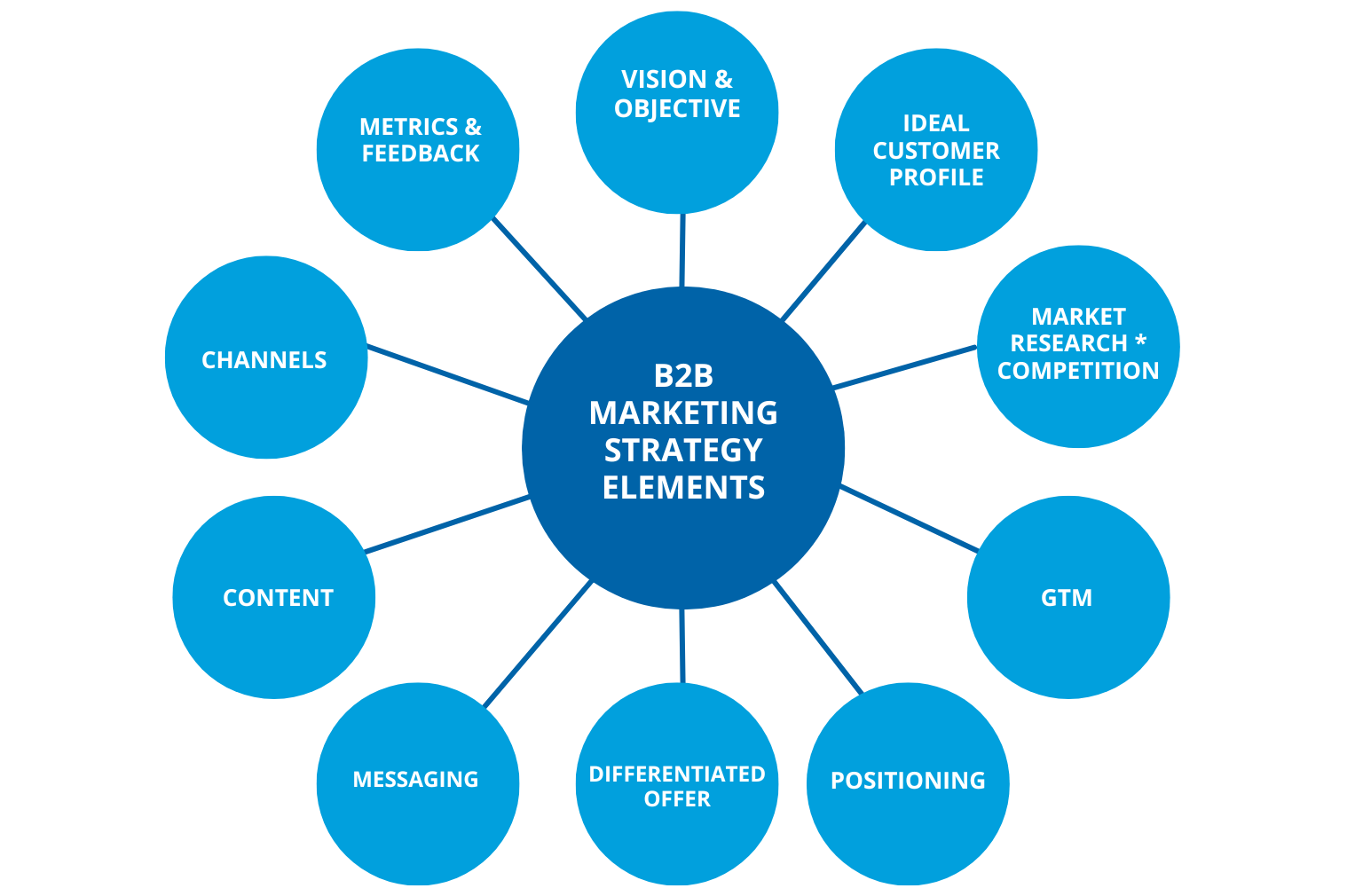Creating a successful B2B marketing strategy doesn’t have to be overwhelming. You can build a strong foundation that drives results by focusing on a few core areas. In this post, I’ll walk you through the top 10 steps to set your strategy up for success and practical actions you can take immediately.

1. Define Your Vision and Business Objective
Before you dive into tactics, it’s essential to understand your company’s vision and long-term business goals. To be effective, a marketing strategy should always be aligned with the company’s overall objectives.
Initial Action to Take
Work closely with your company’s leadership to ensure all marketing goals support the broader business goals. Meet with key stakeholders to clarify these objectives and review them regularly to stay aligned.
2. Develop Your Ideal Customer Profile (ICP)
Knowing who you’re marketing to is key to success. Your Ideal Customer Profile (ICP) defines the customer who will most benefit from your product or service.
Initial Action to Take
Create a detailed ICP by identifying your best customers. Look at their industries, biggest pain points, and solutions they need. A simple way to start is by interviewing a few of your top clients and noting common characteristics.
3. Conduct Market Research and Competitive Analysis
Market research helps you understand the competitive landscape and identify opportunities. Knowing your competitors’ strengths and weaknesses lets you position your offer more effectively.
Initial Action to Take
Start by reviewing competitor websites and marketing materials. Identify what they’re doing well and where they fall short. Look for gaps that you can fill with your product or service.
4. Positioning: Stand Out from the Crowd
Positioning defines how your product or service fits the market and what makes it unique. It’s your chance to show why your company is the best choice for your target audience.
Initial Action to Take
Write a positioning statement that clearly articulates your value. Focus on your product’s specific benefits and how it solves your customers’ problems. Make sure your team uses this statement consistently across all marketing channels.
5. Differentiate Your Offering
While positioning sets your place in the market, differentiation is how you stand out from competitors. What unique qualities make your product better or different?
Initial Action to Take
List the top three features or benefits that set your product apart from competitors. Use this list to guide your messaging and show your audience why your offering is unique.
6. Create a Messaging Framework
With positioning and differentiation in place, your messaging must be clear and consistent across all touchpoints. A strong messaging framework ensures everyone on your team speaks the same language about your product.
Initial Action to Take
Develop a core messaging document that outlines your key messages for each audience segment. Ensure your sales, marketing, and customer support teams use this document to ensure consistency.
7. Build a Go-to-Market (GTM) Strategy
A go-to-market strategy details how you’ll introduce your product to the market and reach your target audience. It includes everything from market segmentation to pricing and distribution.
Initial Action to Take
Create a simple GTM plan by identifying your key audiences and the best way to reach them. Choose the most effective marketing channels and outline how you’ll launch your product.
8. Select the Right Marketing Channels
It is tempting to use every marketing channel available, but a scattered approach can waste time and resources. Instead, focus on mastering one channel before expanding to others.
Initial Action to Take
Start by identifying where your ICP spends their time (for example, LinkedIn for B2B). Choose one primary channel to focus on and master it before adding more channels. Avoid a “spray and pray” approach and track your results closely.
9. Develop a Content Strategy
Content is the foundation of inbound marketing, helping you attract and engage your audience. A strong content strategy aligns with your ICP’s needs and the buyer’s journey.
Initial Action to Take
Create a simple content calendar. Start by identifying key topics that matter to your audience and plan content that addresses their challenges. Ensure each piece of content is tied to a specific stage of the buyer’s journey.
10. Set Up Metrics and Analytics
Tracking your marketing efforts is critical to understanding what’s working and what’s not. Setting up the right metrics helps optimize your strategy and drive better results.
Initial Action to Take
Identify three key performance indicators (KPIs) to track: lead generation, conversion rates, and customer acquisition cost. Use tools like Google Analytics or HubSpot to monitor these metrics regularly and adjust your strategy as needed.
Start with the Basics
Building a strong B2B marketing strategy is all about focusing on the fundamentals. Start by defining your vision, understanding your audience, and positioning your company effectively. From there, build your messaging, select the right channels, and track your progress. By taking these steps, you’ll be well on your way to creating a marketing strategy that delivers results.
This guide gives you the building blocks for success and remember: execution is key. Take these actionable steps and start seeing real growth in your marketing efforts.
You can learn more about our perspective on B2B marketing strategy and how all six elements of an integrated marketing system can work for you.
Recent Comments